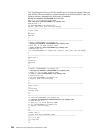
In order for CC and BCC tags to show up in MIME headers (and client screens),
you must set the KEEPRCP parameter to *ALL. BCC recipients are not shown
regardless of the setting of this parameter because they are not intended to be. The
TO and CC recipients will show up in the text of the OfficeVision note.
Sending MIME (POP Server) Mail across a SNADS Network
This section applies only to those situations where:
v You have AS/400 systems connected to each other across a SNADS network
v You are adding (or have added) POP mail clients
v You want these POP mail clients to be able to send MIME mail to each other
between these systems without the mail being handled as OfficeVision mail.
When MIME mail is sent over AS/400 systems connected with SNADS, MIME text
attachments are parsed and converted, and video, audio and image files are
decoded and reformatted as PC files. Because of this processing, a single MIME
message can be converted to many SNADS messages, and some information can
be lost in the conversion. This happens even if a POP mail user is sending mail to
another POP mail user across a network; SNADS assumes that the mail is
OfficeVision mail and handles it accordingly.
SNADS tunneling provides an alternative; it allows POP users to send MIME mail
between AS/400 systems across a SNADS network without the mail being
converted to OfficeVision mail.
How SNADS Tunneling Works
Tunneling refers to a technique in which you send protocol traffic across another
protocol or send data across a protocol that the data was not intended to be sent
across. With SNADS tunneling, a MIME message is encapsulated as a SNADS
object distribution data file. Because object distribution files are treated as binary or
unformatted data, they are passed along as is; no parsing or transformation takes
place.
How to Configure System Distribution Directory Entries for SNADS
Tunneling
Configuring SNADS mail clients to use SNADS tunneling is very simple. All you
need to do is set the
Address type
field in the system distribution directory entry for
the mail clients or system receiving the mail to TNDENDGN. Since you will normally
be using *ANY entries to transport mail to another system, changing this one field
ensures that all MIME mail sent to users on that system (who do not have different
instructions associated with their own individual entries in the system distribution
directory) will be tunneled.
Although mail clients still need to be configured to receive mail, you do not need to
do anything differently for these clients to receive mail that is tunneled through
SNADS (SNA distribution services). Tunneling is determined by the directory entry
for the system to which you are sending mail and only affects the way the mail is
transported (not delivered). Mail recipients, as long as they are using V3R2 or V3R7
and later versions of the TCP/IP Connectivity Utilities for AS/400, are able to receive
both OfficeVision and MIME mail (regardless of whether it is tunneled).
308 OS/400 TCP/IP Configuration and Reference V4R4


















